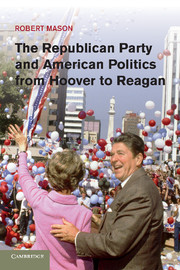Book contents
- Frontmatter
- Contents
- Acknowledgments
- Introduction
- 1 “From Old Home Melodies to Jazz Music”: 1928–1933
- 2 “As Maine Goes, So Goes Vermont”: 1933–1939
- 3 “The Simple Barefoot Wall Street Lawyer”: 1939–1945
- 4 “Liberty versus Socialism”: 1945–1953
- 5 “Modern Republicanism”: 1953–1961
- 6 “A Choice, Not an Echo”: 1960–1968
- 7 “There’s a Realignment Going On”: 1968–1976
- 8 “You Are Witnessing the Great Realignment”: 1977–1989
- Conclusion
- Archival Sources
- Index
- References
1 - “From Old Home Melodies to Jazz Music”: 1928–1933
Published online by Cambridge University Press: 05 December 2011
- Frontmatter
- Contents
- Acknowledgments
- Introduction
- 1 “From Old Home Melodies to Jazz Music”: 1928–1933
- 2 “As Maine Goes, So Goes Vermont”: 1933–1939
- 3 “The Simple Barefoot Wall Street Lawyer”: 1939–1945
- 4 “Liberty versus Socialism”: 1945–1953
- 5 “Modern Republicanism”: 1953–1961
- 6 “A Choice, Not an Echo”: 1960–1968
- 7 “There’s a Realignment Going On”: 1968–1976
- 8 “You Are Witnessing the Great Realignment”: 1977–1989
- Conclusion
- Archival Sources
- Index
- References
Summary
Republican hegemony seemed unassailable in the aftermath of the 1928 elections and Herbert Hoover’s presidential victory. John J. Carson, an aide to Senator James Couzens, a Michigan Republican, observed that “my conviction now is that the Democratic party is through forever.” Not only did defeat characterize most of the Democratic record in electoral politics since the turn of the twentieth century, but the 1928 presidential nomination of Alfred E. Smith, governor of New York, exposed sharp intraparty differences between North and South. The campaign then deepened those differences. Dependably supportive of the Democratic Party since the Civil War, the white South refused to remain united behind the candidacy of a northern Catholic who opposed Prohibition’s suppression of the liquor industry. Carson suspected that the schism was permanent, bringing terminal disarray to a party that even in good health tended to lose American elections. He thought that decades might pass before a new party successfully developed in the ailing Democrats’ place.
Confidence among Republicans in their party’s future was the result of its own strength as well as the Democrats’ weaknesses. Speaking in July 1929 at a Jackson, Michigan, event to mark the party’s seventy-fifth anniversary, Republican National Committee chair Hubert Work identified the nation’s economic success with Republican leadership. “The unprecedented development of this nation can not, by any mental process, be dissociated from the growth of the Republican Party,” Work said. “The public men it has produced have woven the American character into a web of achievements for which the Republican Party has become a symbol.” Work insisted that the tariff that protected America’s economic output from foreign competition was a cornerstone of this history, and he warned that the key threat to Republican-managed success was the advent of a paternalism that favored government possession “of public necessities,” sure to undermine individualistic endeavor. But this reference hinted at one of the party’s weaknesses – an intraparty disagreement about utility ownership, one of a larger set of policy disagreements. Though a major exponent of resource development, Hoover disagreed with Senator George W. Norris of Nebraska, who demanded government rather than private distribution of energy generated by federally supported waterways schemes, especially with reference to Muscle Shoals in the Tennessee Valley – a proposal Hoover later described as “the negation of the ideals upon which our civilization has been based.” Norris, a leading figure in the party’s progressive wing, endorsed Smith instead of Hoover in 1928. But the party’s electoral position was secure enough that disagreements between a few dissident progressives and other Republicans posed little danger to presidential success, to its supremacy within the two-party system. The normal national majority of Republicans over Democrats in the 1920s was five million strong.
- Type
- Chapter
- Information
- Publisher: Cambridge University PressPrint publication year: 2011



